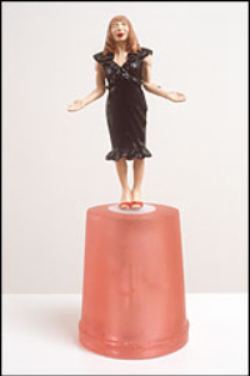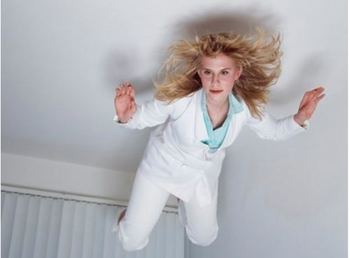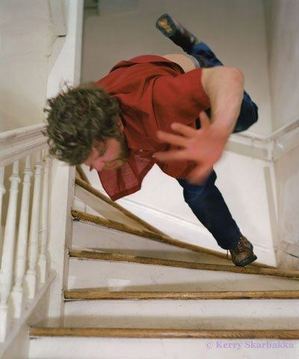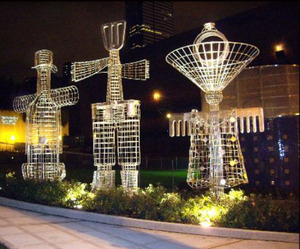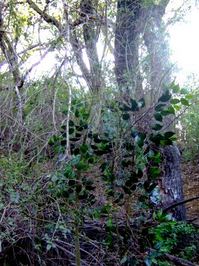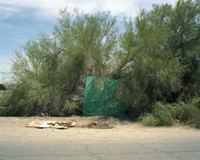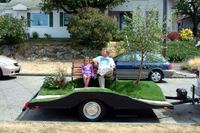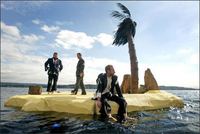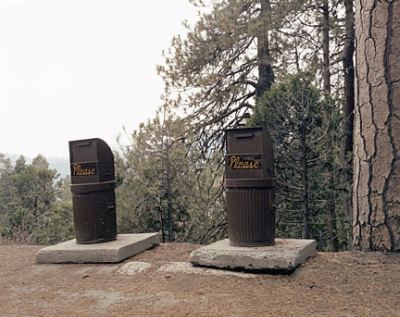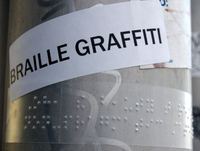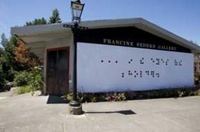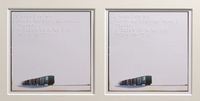[Read more…] about I Believe I can Fly – the Icarus question
Archives for 2009
Public art, from the department of potshots
The best thing about these new sculptures standing next to the east wall of the Paramount Theater is they are fenced in. When the chain-link fence is removed, and there’s nothing between us and them, everything that makes them bad (bad idea, bad imagination, bad motives) will oppress us like the heated talk of a man, a poet, who is excited by the sun of his own inspiration.
I love this paragraph from Charles Mudede, who is the poet of whom he speaks, excited by the sun of his own inspiration. Note he doesn’t mention the artist, Ries Niemi, or the name, rank and serial number of the piece, Eat, Drink, and Be Merry.
Neimi responded by signing, under his name, bad idea, bad imagination, bad motives. Jen Graves added in a later post, “I’m sorry, Ries. But I really can’t countenance those things.”
She noted that the sculptures have been removed to “make way for the next phrase of light rail construction.” She didn’t say the sculptures were commissioned by Sound Transit START Public Art Program, which means they’ll be back.
Images: Click to enlarge. First image from SIMS Conference, 2008, second from Slog.
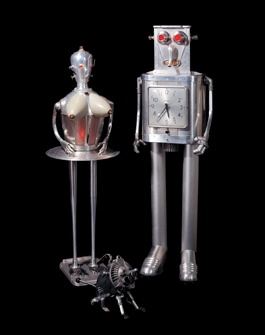
According to the Niemi, his piece consists of…
3 totem poles for the 21’st Century, collaged from images of contemporary culture, food and drink.
Ranging in height from 16 to 18 feet, and 8 feet in diameter, these glittering stainless steel figures are anthrophomorpic but not human. They are made from different textures of forged and fabricated stainless steel.
The site is a small urban park whose reason for existance is the Vent Shaft for the Sound Transit tunnel under Capitol Hill.
In other words, the piece was created to accompany a park that isn’t there yet. Placing it in a bleak section of urban wasteland was intended to perk up the wasteland. Instead, all the ire the place attracts found a focal point. And that’s what Lawrence Alloway, writing brilliantly in the 1970s about public art, thought it should be, a “focal point for an undeferentiated audience.”
At this point, Niemi took a bullet for a hideous stretch of city property. Will the reputation of this piece rise against a better backdrop? If there’s any justice, yes.
The wrong YouTube performance
I’ve got nothing against the YouTube Symphony Orchestra, here. As Anthony Tommasini noted in his NYT review, YouTube could have chosen to present the “YouTube International Basketball team.”
Greg Sandow, on the other hand, found it more than a little suffocating, here. But everybody seems to agree it set a good precedent. What precedent? YouTube chose to play in a concert hall, instead of organizing an event that made sense only online, where it lives.
Playing for Change has already done just that. It collected a great team of musicians from all over the world and linked them through headsets to each other’s contributions. No artist left his or her village, city square or mountain top, and yet everybody was in sync.
Divided by geography, they’re united by the rich tapestry of music they’re hearing as they make it. Had you passed by one of them, you would have seen a solo act. Only online is the global magnificence of the project apparent.
I posted it on ArtsJournal’s main page earlier in the week, but if you missed it there, here it is, a major smack down to those who think life online isolates its audiences. Here’s to the new world, more fun than the old.
The MFA: 20 years of schooling and they put you on the day shift
From Sarah Thornton’s Seven Days in the Art World:
Since the 1960s, MFA degrees have become the first legitimator in an artist’s career followed by awards and residencies, representation by a primary dealer, reviews and features in art magazines, inclusion in prestigious private collections, museum validation in the form of solo or group shows, international exposure at well-attended biennials, and the appreciation signaled by strong resale interest at auction. More specifically, MFA degrees from name art schools have become passports of sorts.
Leslie Dick, the only writer with a full-time position in the art department at CalArts, told Thornton he asks students the following question:
Why come to grad school? It’s about paying a lot of money so you can change. Whatever you thought was certain about how to make art is dismantled. You wobble. You don’t make any sense at all. That’s why you are here.
Dave Hickey told her that he doubts the value of that process.
My one rule is that I do not do group crits. They are social occasions that reinforce the norm. They impose a standardized discourse. They privilege unfinished, incompetent art… If you’re not sick, don’t call the doctor…
I don’t care about an artist’s intentions. I care if the work looks like it might have some consequences.
I’m with Hickey on this one. Doesn’t Dick sound a bit like a cult leader? If you’re not sick, don’t call the cult leader. Paying a lot of money to study a collective version of the meaning of meaning might make sense in flush times, for those inclined. But for those who don’t have family money and are going into debt for the privilege, I think its virtues are overrated.
I’ve been thinking about this since Todd Simeone opened at the James Harris Gallery. Simeone was showing in Seattle before he got a BFA from the University of Washington in photography in 2005. By the time he left town to get an MFA from the University of Illinois at Chicago, he was on the regional charts with a bullet, ready to hold his own in a larger context.
He believes that graduate school helped him focus, and that may be true. What’s also true is that it appears to have (temporarily) killed his spark, his juice, the thing that made him singular – a commitment to imagery that makes an electric connection between audience and art, allowing them to rearrange and enlarge their understanding of the world of things.
I also think, for someone like Simeone, interested in a progressive version of the landscape, there’s a lot more going on in that vein in Seattle than Chicago, where he is now and his Seattle dealer advised him to stay.
[Read more…] about The MFA: 20 years of schooling and they put you on the day shift
Whiting Tennis – the unmangeable, idosyncratic intensity of form
Cable Griffith interviews
Whiting Tennis, who opens Friday night as part of Dimensional Invention at the Kirkland Arts Center, curated by Griffith.
Wynne Greenwood: Samuel Beckett meets borderline personality disorder
Update, 4/18: I changed this review to praise Greenwood more, adding to dry wit “perfect timing and sculptural use of language.” This piece grew on me in retrospect.
Wynne Greenwood can sing. The almost complete suppression of her singing is part of her performance at On the Boards, titled, Sister Taking A Nap.
The 40 30-minute piece (said 40 in the program notes) finds Greenwood’s character with not a lot to do. A friend calls. She says she needs a ride if she’s going out and adds that she can’t give directions to her sister’s apartment because she doesn’t know where it is, and her sister is sleeping.
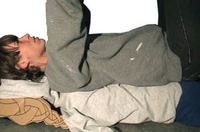 Our heroine might go for a run but can’t find a pen to leave a note. (“Where are your pens? … Seriously.”) For a poet-sister not to have pens around is telling. Back to the heroine, who’s hungry. She says so several times. To no avail, she tries to wake her sleeping, former-poet sibling, who is a half-drawn, half-stuffed puppet prone on the floor.
Our heroine might go for a run but can’t find a pen to leave a note. (“Where are your pens? … Seriously.”) For a poet-sister not to have pens around is telling. Back to the heroine, who’s hungry. She says so several times. To no avail, she tries to wake her sleeping, former-poet sibling, who is a half-drawn, half-stuffed puppet prone on the floor.
Gina Young plays the role of Greenwood’s shadow. Since Greenwood is already her own shadow, Young pulls off a monumental act of self-suppression. She’s there, and she’s not. She holds a light, paints a plaster bird black (no need to say nevermore), chips away at Greenwood’s pink plaster suitcase, which, having no opening, doesn’t.
Greenwood’s lithe young thing is monumentally self-absorbed. She might as well be a potted plant, because she expects watering. This kind of person does not age well. As presented in Sister Taking A Nap, she’s a drain on everybody except the members of the audience, who respond to Greenwood’s dry wit, perfect timing and sculptural use of language.
Greenwood got her start in the music scene
in Olympia in the late 1990s, which is where she launched Tracy + the
Plastics. The group featured her and her sisters. If she has any sisters, they weren’t in the band.
A Russian joke comes to mind: Two Russians meet on the street, and one asks the other:
Is it true that you formed a musical group?
Yes, a quartet.
How many members?
Three.
Who?
Me and my brother.
You have a brother?
No.
Tracy + the Plastics was Greenwood times three. When on stage, she fronted multiple video screens featuring her alter egos. Sometimes there was a video dog. Sometimes there were sculptures that turned into drums or hatched, like eggs, to offer tea with milk and honey.
There are legions of visual artists who’d like to be musicians and
musicians who boast about their art chops, but few are equally good at
both. Greenwood is the rare, real deal. She fused video and music with
performance stand-up: low-tech/high-concept, kick-butt, punk-tinged,
art-based rock ‘n roll.
Right now she really is alone, even though she’s working with Young. Keeping hope alive, she says she’s going to release another record. I can’t wait.
Bad At Sports on Sister Taking A Nap, here. By noon on Thursday, there will be audience reviews of the show, courtesy of Blog the Boards.
The unnautral helping hand of art
In droughts in Southern California, concerned homeowners paint their dead grass green.
For Michael Buitron and Manya Fox, a similar strategy became a critique. Instead of disguising a problem, they highlighted it. Buitron added plastic leaves to bare branches in his project, Four Los Angeles Parks. Fox flung a deep green tarp over a dead spot.
Then there’s SuttonBeresCuller, replacing nature with a madcap, Bladerunner zeal. Below, images from their portable park, fake island in the real Lake Washington and their green cave of a mini-mart, the last still in progress.
John Sutton, Ben Beres and Zac Culler are represented in Seattle by Lawrimore Project.
Baby please. I’m a trash can down on my knees.
Braille graffiti
Here’s a project from 2007 that deserves to be revived and spread, from Scott Wayne Indiana in Portland, Oregon.
(Click images to enlarge)
Two years earlier in Seattle, Spike Mafford made an attempt to connect with the blind in a photo exhibit at Francine Seders Gallery.
Twenty-five years before that, Buster Simpson mounted a series of Cherry tree branches along Pine Street, from the Pike Place Market to First Avenue. Along the underside were messages in Braille. It was part of Simpson’s failed campaign to save a Cherry tree from developers’ plans to remove it. After he lost, he used parts of the tree for a range of art projects, none of which are online. Late Simpson does not appear to value early Simpson. His Web site tracks only projects from 1989 onward.
Trophies – You are already a winner
From Hilarie M Sheets in the New York Times, a feature on Jean Shin’s elaborate trophy landscape at the Smithsonian American Art Museum, opening May 1. (Story here.)
Shin, who refashioned thousands of trophies, did not need to look far and wide for material. Trophies are everywhere.The cheap charm of pats on the back disguises the ruthless sorting of unregulated Capitalism.
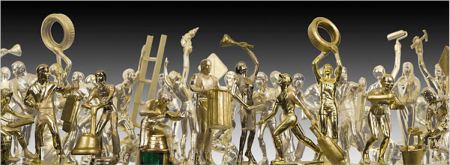 Do-Ho Suh turned a mass of humanity into a trophy for an overlord.
Do-Ho Suh turned a mass of humanity into a trophy for an overlord.
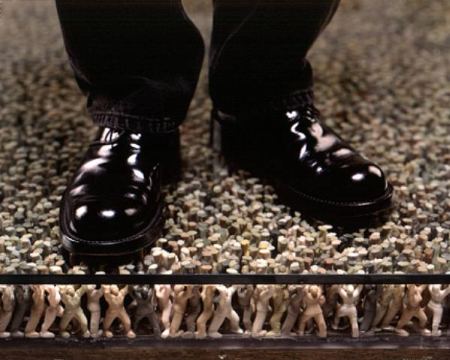 Christian French turned his into a storefront shrine – buy your Buddhism here.
Christian French turned his into a storefront shrine – buy your Buddhism here.
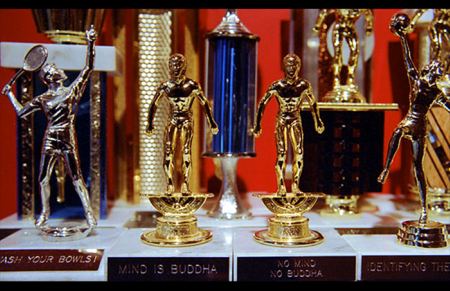
Sherry Markovitz recast a hunter’s prize as an emblem of the spiritual realm.
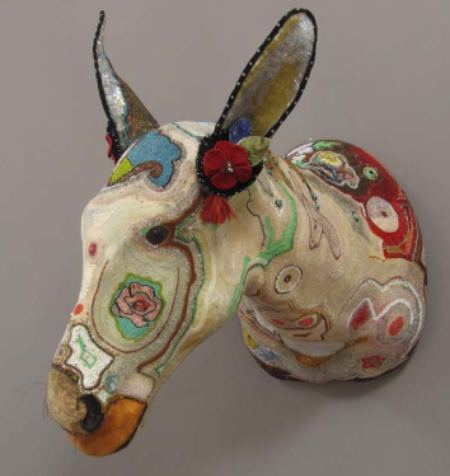
Nicola Vruwink made a trophy of herself. It’s herself she can’t get away from, with all the years of training in the art of feminine wiles. As Oscar Levant said years ago about Doris Day, “Nobody loves a fairy once she’s 40.”
